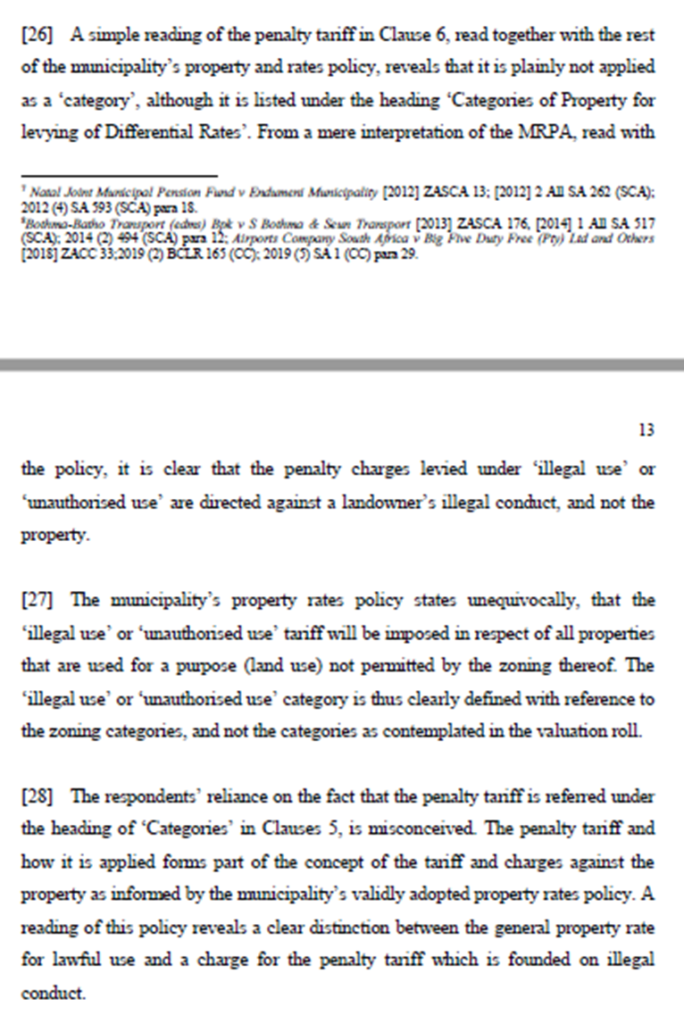
Article by Chantelle Gladwin-Wood, Partner and Maike Gohl, Partner at Schindlers Attorneys
18 July 2022
Introduction
This article takes a critical look at the legality of the City of Johannesburg Metropolitan Municipality (“the City”)’s new method of charging ‘penalty rates’ charges as ‘sundry charges’. The City has started charging penalty rates charges to customers differently, under the sundry section of the municipal invoice. An example of this would be:
| City Of Johannesburg Sundry | VAT 4760117194 | Sub-Total | Total Amount |
|---|---|---|---|
| Property Rates: Unauthorised Use Penalty Charge: | 254,825.17 | ||
| Less property rates charge | -42,230,25 | ||
| Surcharge on business Services, excluding property rates | -3,682.10 | ||
| Surcharge on business Services, exluding property rates | 4,197.23 | ||
| VAT: 0% | 0.00 | ||
| VAT: 15.00%: | 77.26 | 213,187.31 |
The purpose of this article is to consider whether these charges are lawful or not.
As far as the authors can tell, this occurs where the City is of the view that the property owner (or occupant) is breaching the City’s zoning or building laws and the City is penalising them for their unlawful actions by increasing their municipal charges. To understand why this is happening, and whether it is lawful, we first have to take a trip down memory lane and look at how the City previously used to charge penalty rates charges and the laws that relate to these kinds of charges.
Penalty Rates Charges
In terms of the City’s prevailing (current) rates policy read with its prevailing tariffs, the City proclaims for itself the entitlement to charge “penalty rates charges” to a property owner who complies with the requirements set out in the “Penalty Tariff” category in the City’s rates policy. The conditions are as follows:
PENALTY TARIFF
Unauthorised use
(i) This penalty tariff is charged on all properties that are used for a purpose (Land use) not permitted by the zooming thereof in terms of any applicable Town Planning Scheme or Land Use Scheme; abandoned properties and properties used in contravention of any of the Council’s By-Laws and regulations, which include the National Building Regulations and Building Standards Act, 103 of 1977, and any Regulations made in terms thereof. This penalty tariff also covers illegal advertising as regulated by the City of Jahannesburg advertising bylaw.
This rates policy (when read with the tariff) permits the municipality to charge up to 6 times more for rates for a property of the same value in the residential category, if there is a zoning (permitted land use) or building or advertising by-law violation at that property.
What is very important to understand is that these charges are very specifically ‘rates’ charges – which are calculated based on the municipal valuation of the property and levied in terms of the Local Government: Municipal Property Rates Act (“the Rates Act”).
Are Penalty Rates Charges Lawful? The Zibi judgment
This is a complex issue and one that has been debated in several complex cases, the evolution of, and reasoning in which, is difficult to follow, even for a trained legal practitioner.
It was first decided by our courts that the City has the power in law to create a rating category for “penalty use”. This was decided by the Supreme Court of Appeal in the Blom case.[1] Whilst this was (in our view) an incorrect and unfortunate finding, this was not an issue in the Smit case that we introduce next.
It was later argued in Smit[2] (and also argued to a degree in Blom) (both in the High Court) and accepted by the courts in both instances, that a municipality could only charge a customer penalty rates charges (levied in terms of the Rates Act) if the municipality followed the processes set out in the Rates Act to change the property’s category to ‘illegal use’, as provided for in the rates policy.
It is very important to understand here that there is a difference between a rates category (meaning the category, created by the rates policy, that sets out which ‘boxes’ the municipality can choose from to categorize every property in the area), and a rates tariff (meaning the amount of money charged by the municipality for services and rates).
In Blom and Smit, it was accepted by the courts that the tariff (the price charges for rates) was inextricably linked to the rating category, and that the municipality couldn’t leave a property in the residential rating category but charge it penalty rates tariffs (which are 6 times higher than residential tariffs). On this basis, the key finding being that to change the tariff (price) applicable to the property’s rates charges, the municipality first had to follow the processes in the Rates Act to change the property’s rating category to illegal use, Blom and Smit held that the municipality’s illegal rates charges in those cases were unlawfully levied. Shortly thereafter in Zibi, [3] which started before the High Court but ended up at the Supreme Court of Appeal, the same issue was argued. However, the argument in Zibi contained a few twists to what had been argued before in Blom and Smit. In Zibi, it was argued that although the municipality had made the penalty charges (referred to as penalty tariffs) look like they were actually part of the rates charges for the property, because they were mentioned in the municipality’s rates policy, they actually weren’t real rates charges in terms of the Rates Act. Instead they were simply another kind of penalty charge that the municipality was entitled to impose in terms of other laws (specifically certain provisions of the Constitution and the Local Government: Municipal Systems Act). The Supreme Court of Appeal agreed with this argument and held that the penalty charges weren’t really rates charges – they were actually just normal penalty charges – and therefore it followed that the procedures set out in the Rates Act did not need to be followed to first change the rating category to illegal use before the penalty charges could be levied. This was the finding of the majority of the court (which was split in this case), and so it is binding. The effect in law is that, unless overturned by the Constitutional Court, it is lawful for a municipality to charge penalty charges to customers based on their unlawful use of property. The Court said at paragraphs 26 – 28:

We agree that a municipality has the power to raise penalty charges. However, the way in which the municipality choses to create those charges, must be lawful in and of itself. The correct process to create that kind of charge must have been followed, and when levying that charge, the correct administrative law process (for example, allowing people to make representations if they are affected adversely and materially by the imposition of those charges) must be provided for in law, failing which the levying of the charge (alternatively the charge itself, and the empowering legislation or policy in terms of which it is levied) must be set aside in law as being unlawful.
Whilst we accept that in principle a municipality has the power in law to create tariffs that impose penalty charges upon customers for all sorts of things (for example, meter tampering as well as illegal use of property), we do not accept that if these charges are created as penalty rates charges that flow from the illegal use rating category in the rates policy under the Rates Act, that this can happen without the municipality following the processes in the Rates Act to change the rating category to illegal use first.
If the municipality choses to create penalty charges for illegal use in another way – for example, to put them into its tariffs promulgated annually but as general surcharges raised in terms of the power accorded to municipalities under the Constitution and Systems Act – and not as rates under the Rates Act – then hypothetically these penalty charges may lawfully be imposed without the municipality needing to follow the procedures set out in the Rates Act to first put the property onto a roll and recategorize it to be in the illegal use category. This does not mean that there will be no process at all that the municipality has to follow before implementing penalty charges – to the contrary, in terms of the Promotion of the Administration of Justice Act (“PAJA”) a municipality is required to notify a customer if they are going to take a decision which will materially and adversely affect that customer and give that customer the opportunity to make representations to it. There are also other administrative law rights that accrue to the customer in such a situation which the municipality would have to adhere to, in order to render the levying of the penalty tariff in any particular case, lawful, both substantively and procedurally.
It is also not correct that a municipality has the power in law in terms of the provisions of the Rates Act (in terms of which the penalty charges in Zibi were created) to create penalty tariffs that relate to something other than rates. This is clearly ultra vires the Rates Act. The municipality is most welcome to, and in fact, does, create penalties for non-compliance with town planning and building violations, in the town planning and building laws. But it is not empowered in law to do so in terms of the Rates Act specifically – which is what the municipality did in the cases of Blom, Smit and Zibi.
In the Blom, Smit and Zibi cases the municipality clearly and specifically raised the charges as penalty rates charges under the Rates Act, based on the category of the property being unlawful use. The majority in Zibi therefore erred in finding that the kind of penalty rates charge raised to the Zibi’s municipal account was lawful, because it was specifically created in terms of the Rates Act, and not in terms of the municipality’s general power to raise penalty tariffs under other legislation. Had these types of charges been raised in another way, perhaps generally under some or other tariff, they may very well have been lawful, but this was not what happened factually in those three cases.
Part of the reasoning of the majority for its finding that the municipality did not need to first put a property onto the property roll and recategorize it into the illegal use category before levying penalty charges, was that it would be an administrative burden upon a municipality to do so. With respect, this is not a valid reason for absolving the municipality from complying with very clear laws that pertain to how a property is to be recategorized, which laws have been created specifically to protect a customer’s administrative law rights and constitutional property law rights to object, appeal or review an incorrect categorisation by the municipality. A municipality cannot shirk its legal responsibilities to its customers purely because it is inconvenient for it to carry out these responsibilities.
Acting Judge Carelse, of the Supreme Court of Appeal, writing for the minority correctly and neatly explained the above in the Zibi case, but because her judgment was in the minority and the majority found to the contrary, the Zibi case does not stand as authority for this point (although it will do so if appealed to the Constitutional Court and the Constitutional Court finds that this point is valid). Judge Carelse also (in our view correctly) found that the City is not lawfully entitled to create a penalty use or unauthorized use rating category at all – her reasons for this finding are clearly elucidated in paragraphs 52 – 59 of Zibi. She shows why Blom was wrongly decided quite aptly.
Another important argument that has not received adequate attention is that the judgment in the Blom case was wrongly decided because it does not take into account section 46 of the Local Government: Municipal Property Rates Act, which provides that unlawful use of a property may not be taken into account for determining the market value of the property. The argument goes that this precludes a municipality from looking at unlawful use as a factor when deciding which rating category to put a property into, and by extension, that it precludes a municipality from creating an unlawful use category to start with.[4] Had this argument been before the Supreme Court of Appeal in Zibi, it may very well have changed the decision of the majority because the majority appears to have understood that the rating categories on the property roll are only meant to exist to be choices relating to lawful use. Judge Carelse pointed this out in para 54 of the Zibi judgment.
In our view then the Supreme Court of Appeal’s majority decision in Zibi is plainly incorrect and ought to be appealed to the Constitutional court, alternatively the judgment challenged in another case before the Constitutional Court for being plainly incorrect.
Now that we understand the history behind the challenge in law to the manner in which the municipality raises penalty rates charges, we can look at how this works in practice.
How Does the COJ Raise Penalty Rates Charges?
These charges are levied by the COJ on a customer’s rates statement by indicating under the “Rates” section of the municipal invoice that the tariff charged is the penalty use tariff, although this appears from the cent in the rand ratio that is used in the rates calculation and not from words that expressly explain this. An example would look like this:
Sundry Rates Charges
The new way in which the City is charging penalty rates charges, is like this:
| City Of Johannesburg Sundry | VAT 4760117194 | Sub-Total | Total Amount |
|---|---|---|---|
| Property Rates: Unauthorised Use Penalty Charge: | 254,825.17 | ||
| Less property rates charge | -42,230,25 | ||
| Surcharge on business Services, excluding property rates | -3,682.10 | ||
| Surcharge on business Services, exluding property rates | 4,197.23 | ||
| VAT: 0% | 0.00 | ||
| VAT: 15.00%: | 77.26 | 213,187.31 |
“Sundry” is a catch-all phrase that refers to a variety of items that are collected together in a category because they can’t be allocated to other, more specific categories.
The City has been charging “surcharges” on business customer accounts (which is calculated as a fixed percentage of the customer’s electricity and water charges) for several years under the “sundry” section. These charges are set out in the City’s tariffs. But the City has never, before recently, charged penalty rates tariffs under the sundry section – as explained above it always historically charged them under the rates section.
We assume that the City’s change in its billing methodology was adopted in order to avoid future challenges to the penalty rates charges based on the majority finding in Zibi. We assume that the City felt that it was safer to raise penalty charges for unlawful use of property not specifically as a property rate under the Rates Act, but rather as a general penalty charge under its tariffs. We assume that’s why it has changed where the charge appears on its invoices. If this is what the City is doing, it isn’t doing it very well, because the method that it is
| City Of Johannesburg Property Rates | VAT 4760117194 | Sub-Total | Total Amount |
|---|---|---|---|
| Category of Property: Property Rates Business The property rates are based on the market values of the property and are calculated as follows: | |||
| R24,510,000.00 x R0,0190970 / 12 (Billing period 2019/06) | 0.00 | ||
| R24,610,000.00 x R0.0440700 / 12 (Billing period 2019/06) | 90,380.23 | ||
| VAT: 0%: | 0.00 | 90,380.23 |
using still indicates very clearly that these charges are still ‘rates’. The notation ought to be amended to refer only to penalty charges or tariffs.
Secondly, before the City can charge any sundry or surcharge, it must be authorized by law to do so. It is absolutely correct that the City has a general authorisation to levy charges of these kinds in terms of the Constitution and the Systems Act, but in order for the City to lawfully levy these kinds of charges they must be set out in the City’s tariffs at the very least. In the case of the City, however, there is no allowance or provision in the City’s prevailing (2022/2023) tariffs for any sundry charges except in relation to work done by Joburg Water for inspections and repairs to drains and gullies.
If the City’s tariffs do not permit a certain charge, it is unlawful. As there is no lawful authorisation for the City to charge penalty rates charges as sundry charges, this method of charging a customer for penalty rates, is also unlawful.
VAT Charges
Sundry charges are also a type of charge that would attract VAT, because they are charges for services rendered. However, the City is not charging VAT on the penalty rates charges that are contained in the sundry section of the City’s invoices, indicating that the charges are not for services of any kind but for rates (upon which VAT cannot lawfully be levied). This is another indication that the charges in the sundry section are still rates charges, and not proper tariff or penalty charges.
Prescription of Sundry Charges, Surcharges or other Penalty Charges
If the charges levied by the City under its sundry section are true “sundry” charges or “surcharges”, they would prescribe after 3 years (and not 30 years, as charges for rates would).
Conclusion
The City therefore needs to think carefully about what kinds of charges it is levying, and it needs to ensure that it follows the correct procedures to levy those charges – both in terms of having proper authorisation in law to charge them and in terms of allowing customers the proper administrative law rights to challenge those charges.
The City might be lawfully entitled to charge some kind of penalty charges for violations of the various town planning and building laws in terms of the Constitution and Systems Act generally, but only if, at the very least, these were contained in its tariffs and sufficient administrative law protections for customer were built into the process of levying these charges.
The City is not (or at the very least, ought not to be) lawfully entitled to raise penalty rates charges under the Rates Act without following the prescripts thereof. If you are uncertain as to whether or not the charges levied to your account are correct, seek legal advice in relation to same.
[1] City of Tshwane v Marius Blom & GC Germishuizen Inc and Another (433/2012) [2013] ZASCA 88; [2013] 3 All SA 481 (SCA); 2014 (1) SA 341 (SCA) (31 May 2013).[2] Smit v City of Johannesburg Metropolitan Municipality (02181/2016) [2017] ZAGPJHC 386 (28 November 2017).
[3] City of Johannesburg Metropolitan Municipality v Zibi and Another (234/2020) [2021] ZASCA 97; [2021] 3 All SA 667 (SCA); 2021 (6) SA 100 (SCA) (9 July 2021).
[4] This argument was raised by expert valuer George Nel with the authors. Our many thanks to him for his continued expert advice in these matters.

Chantelle Gladwin-Wood
Partner at Schindlers Attorneys
Phone: +27 (0) 11 448 9678
gladwin@schindlers.co.za

Maike Gohl
Junior Partner at Schindlers Attorneys
Phone: +27 (0) 11 448 9679
gohl@schindlers.co.za

